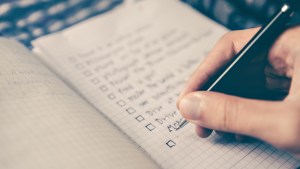I write myself a to-do list at least three times a week, and it almost always makes me feel instantly overwhelmed. I couldn’t figure this out for the longest time. After all, it genuinely helps to get all of my different responsibilities down on paper in some kind of concrete way, and in theory, it breaks up a daunting day into bite-sized pieces. What’s the problem, then? Turns out it’s not the list, so much as how I’ve been writing it. I’m working on cutting out these four mistakes, and lo and behold, I’m getting stuff done again.
1. My list is way, way too long
By the time I’m anxious enough to feel the need to put a list on paper, I’m in full on desperation mode. So instead of just writing down the most important things, the ones that are going to make a difference, I’ll write anything and everything I can think of. If everything gets done, I’ll have to feel better, right? That would be true if I was actually going to do it all, but that never happens. Instead, I get daunted, and put off even starting. And when I do manage to cross a few projects off the list, I still get to feel like a failure at the end.
2. It’s not ordered by priority
I’m seriously indecisive, so trying to prioritize anything makes me itchy. It’s hard to settle on an order of importance that I won’t second guess, but I’m biting the bullet and making myself commit to an order, because otherwise I might answer some emails first, sure, but then when it’s time for grading a pile of tests, I tell myself I’ve earned a break, and somehow, predictably, find myself scrambling to meet my deadlines, one more time.

Read more:
How writing old-fashioned to-do lists improves your productivity
3. It’s too vague
I like to imagine that once I get going, I’ll be some kind of superhero of productivity, so instead of writing, sensibly, “mop the kitchen, and vacuum the living room,” I take a go-big-or-go-home stance, and write CLEAN ALL THE THINGS. Hope springs eternal, after all. Except, obviously, instead of cleaning up the rug and the linoleum, I end up cleaning nothing, because there’s no way I’m starting a job that has no end in sight. If I am never going to get the satisfaction of crossing it off the list, it’s never going to happen.
4. I let myself multitask
I wasn’t surprised to find a Stanford study that backed up my gut feeling here. Apparently, multi-taskers are generally less efficient and productive than people who finish the first thing before they move on. I’m a product of my generation — none of us are capable of staying on one browser tab for more than five minutes — and the habit was killing my productivity, because if I get bored and move on to another job, the first one is never going to get done.
All in all, when I’m firm with myself, I’m getting a lot more done now than I was. They’re not complicated ideas, and they’re not new. I got most of these ideas from something called the “Ivy Lee” productivity method. Lee was a productivity consultant in the early 1900s with an absurdly simple process, too simple not to work, actually.

Read more:
A happy workplace increases productivity — but how do you create one?
Essentially, he says, in the evening write down the six most important things you need to do the next day, and in the morning, tackle them one by one in order of priority. Whatever doesn’t get done gets bumped to the top of the next day’s list. It hit me that most of the problems that were holding me back had to do with me overcomplicating things, biting off more than I can chew, or not staying focused, so a simple method was what I needed.
Simple doesn’t mean easy, and following Lee’s method takes a fair amount of concentration and will power, but it’s memorable enough to keep me on track, it never feels as daunting as my old to-do lists did, and somehow, I manage to get things done when I stick to the it, so I’m sold.

